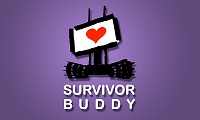Click here to see Survivor Buddy 2.0
Winner 2009 Popular Science 100 Best of What’s New
Subject of Emmy Award Winning PBS SciGirls episode: Robot’s to the Rescue!
Survivor Buddy 2.0 as part of Smithsonian exhibit for National Robotics Awareness Week
Welcome!
The Survivor Buddy Project is a joint project between Texas A&M and Stanford developing a web-enabled search and rescue robot that can be retrofitted to any rescue robot (the Survivor Buddy “head”) while advancing our understanding of computers and robots as a social medium. It’s not just what the Survivor Buddy transmits but how it does it that is important; to paraphrase Marshall McLuhan, the social medium is the message.
Motivation
Robots are being considered for applications where they serve as proxies for humans interacting with another human. One example is point-of-injury care, where a person is trapped in a building collapse or deep within a multi-vehicle car crash. Consider that two trapped Australian miners requested MP3 players with a Foo Fighters Album while waiting for rescue. In these domains, the human (“dependent”) is connected to multiple other humans (“controllers”) via the robot proxy for long periods of time. The literature already shows that the dependent in search and rescue scenarios will respond to the robot, raising the possibility of becoming distrustful as well as cognitively confused by a robot that presents a different affect for different controllers rather than a consistent communication strategy. Although there is great interest in para-linguistic affective relationships, no formal and comprehensive models of relationships and associated communication strategies exist.
History and Funding
The Survivor Buddy project originally started in 2001 in the aftermath of the World Trade Center disaster. Prof. Robin Murphy, director of the Center for Robot-Assisted Search and Rescue (CRASAR) began to wonder how a robot could be used effectively by responders and medical personnel to not only extract information but provide comfort. A team of undergraduates at the University of South Florida entered the IEEE Computer Society International Design Competition created a Bluetooth enabled VOIP “brick” that a robot could deposit with a survivor, then go off and continue the search.
In 2007, Prof. Clifford Nass and the Communication Between Humans and Interactive Media Lab (CHIMe) joined the effort with Murphy and Dr. Jenny Burke, a CRASAR research scientist, and the Survivor Buddy Project was initiated with a human-robot interaction grant from Microsoft External Research. The “brick” had evolved into a web-enabled multi-media “head” providing a richer range of interaction and more options for a trapped survivor. In the middle of the project, Prof. Murphy moved to Texas A&M, while USF PhD students Jeff Craighead and Cindy Bethel continued their work co-directed by Prof. Larry Hall.
In 2009, the National Science Foundation awarded Murphy and Nass a $1.3M grant (No. 0905485) to investigate the fundamental science issues identified through the Microsoft funded effort and new studies suggesting the importance of verbal and non-verbal affect in creating robots that are comforting and trustworthy. Any opinions, findings, and conclusions or recommendations expressed in this material are those of the author(s) and do not necessarily reflect the views of the National Science Foundation. Prof. Takis Zourntos joined the effort and is an active contributor.
